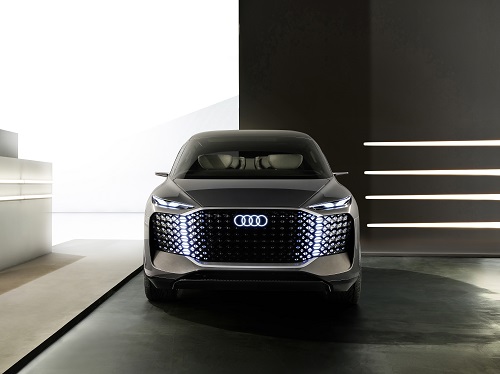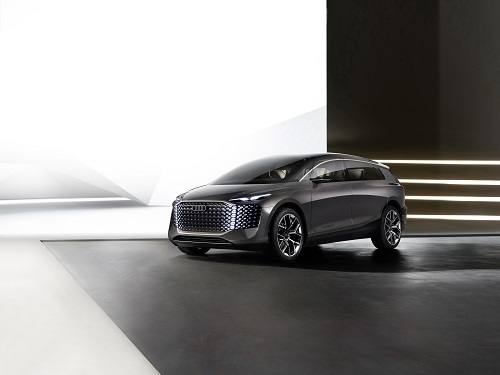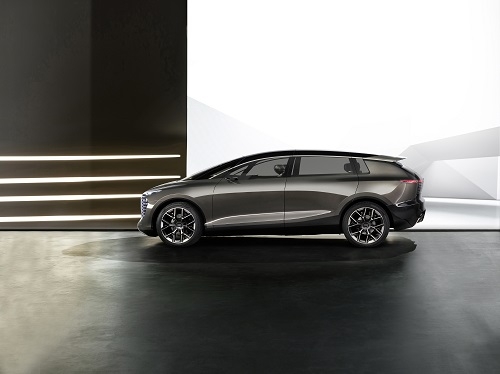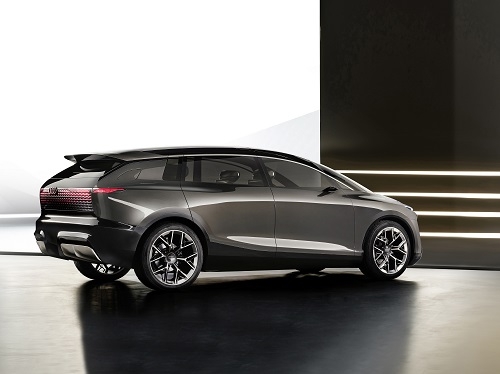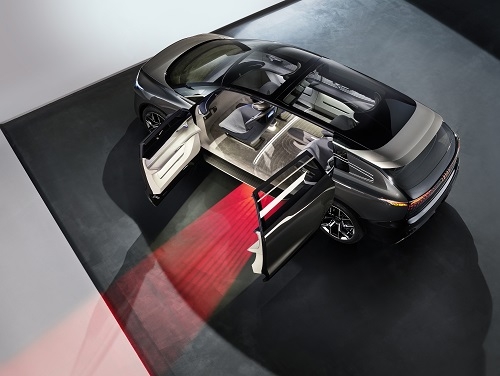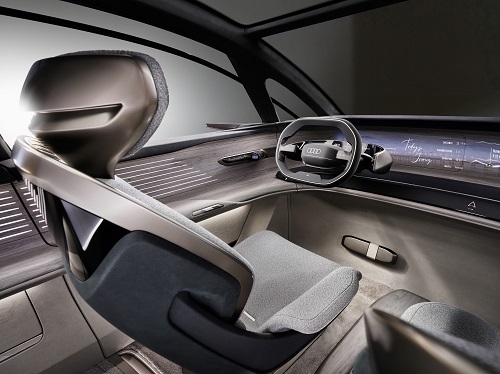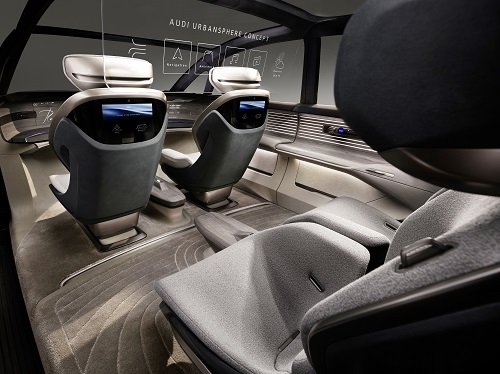Systematically designed from the inside out – Audi is presenting the Audi urbansphere concept car. Designers and engineers have created the Audi urbansphere primarily for use in traffic of Chinese megacities. In these metropolitan areas, where personal space is in particularly short supply, the concept car offers the largest interior space of any Audi to date. In addition, it intelligently coordinates this with technologies and digital services that appeal to all the senses and thus offer a new quality of experience.
The doors of the Audi urbansphere concept are counter-hinged at the front and the rear; there is no B-pillar. As a result, the whole world of the interior opens up to passengers as soon as they climb in. Seats that swivel outward and a red carpet of light projected onto the ground next to the vehicle transform the simple act of entering the car into an experience of comfort.
A wheelbase of 3,400mm and a vehicle width of 2,010mm delineate what is a more than stately footprint, even for a luxury-class automobile. Together with 1,780mm of headroom and expansive glass surfaces, these dimensions result in an exceptionally spacious experience of the interior – both subjectively and objectively.
Four individual seats in two rows offer passengers luxurious first-class comfort. The seats in the rear offer particularly generous dimensions and a wide range of adjustment options. In Relax and Entertain modes, the backrest can be tilted up to 60 degrees while leg rests extend at the same time. The centre-mounted armrests integrated into the sides of the seats and their counterparts in the doors create a comforting feeling of security.
The seats also cater to the changing social needs of passengers in a variety of ways. While conversing, passengers can turn to face each other on their swivelling seats. On the other hand, those who want some seclusion can conceal their head area from the person next to them using a privacy screen mounted behind the headrest. In addition, each seat has its own sound zone with speakers in the headrest area. Individual monitors are also built into the backs of the front seats.
When passengers want to use the infotainment system together, on the other hand, there is a large-format and transparent OLED screen that pivots vertically from the roof area into the zone between the rows of seats. Using this “cinema screen,” which occupies the entire width of the interior, the two passengers in the back row can take part in a video conference together or watch a movie. Even split-screen use is possible. When the screen is not in use, it offers a clear view to the front thanks to its transparent design –or when folded upwards –also through the glass roof area to the sky.
Like in the Audi grandsphere concept, the interior of the urbansphere blends space and architecture, digital technology, and authentic materials into a single entity. The lines emphasize the vehicle’s horizontal proportions.
The open, wide interior supports the impression of a one-of-a-kind space. The steering wheel, pedals, and conventional dashboard can be hidden during automated driving, which enhances the feeling of transparency and spaciousness.
The seating surfaces and backs of the two seats with integrated seat belts are visually separate. Between the rear seats – normally locked in place in a low position – is a centre console that swivels upwards. It contains a water dispenser and glasses – another testament to the Audi urbansphere concept’s first-class credentials.
The Audi urbansphere also qualifies as a wellness zone thanks to innovative digital options that emerged in no small part as a result of the input from the co-creation process with Chinese customers. Stress detection is a prime example – this adaptive program uses facial scans and voice analysis to determine how passengers are feeling and offers each of them individual ways to relax, for example with a meditation app that can be used via the personal screen and the private sound zone in the headrests.
A grand, and undoubtedly self-assured, appearance – one’s first encounter with the Audi urbansphere concept is certain to leave an impression. A length of five and a half metres, its height of almost 1,780mm, and its width of more than two metres are undoubtedly prestigious enough to rub shoulders with the automotive elite.
The flowing silhouette of the vehicle body features traditional Audi shapes and elements, but are combined here to create a new composition – the distinctive Singleframe with the digital eyes of the adjacent lighting units. Viewed from the side, is the widely curved, dynamic roof arch, a massive sill that conceals the battery unit, and large 24-inch wheels. They reference an icon of the 90s – the Audi Avus concept car. The six double spokes simultaneously convey lightweight design and stability, reminiscent of functional motorsport wheels and the Bauhaus tradition of the brand’s design.
The implied wedge shape of the vehicle body is emphasized by the large, flat windshield. At the front and also at the rear, there are large digital lighting surfaces that leave their mark on the design and at the same time serve as communication elements.
The Audi urbansphere defies classification into conventional vehicle categories. Nevertheless, it reveals itself to be a typical Audi at first glance. The similarities to the Audi grandsphere concept are particularly eye-catching. The monolithic design of the vehicle body is common to these two concept cars, as is the sculpted, soft shape of the wheel arches. A long wheelbase of well over three metres and short overhangs indicate that this is an electric vehicle. Elegance, dynamism, an organic design language – these are the attributes that immediately spring to mind despite the stately proportions of the Audi urbansphere, just as they do in the significantly flatter grandsphere.
The heart of the drive system is the 800-volt charging technology. It ensures that the battery can be charged with up to 270 kW at fast-charging stations in the shortest possible time. As such, charging times are approaching those of a conventional stop to refuel a car powered by an internal combustion engine, as just 10 minutes are enough to charge the battery to a level sufficient to power the car more than 300 kilometres (186 miles). In addition, the battery, which holds more than 120 kWh, can be charged from 5 to 80 percent in less than 25 minutes. This means that a range of up to 750 kilometres (466 miles) can be expected acing to the WLTP standard –and even when used for more energy-intensive city and short-distance trips, it is generally possible to avoid making unexpected stops to charge.
